GET GUARANTEED SATISFACTION OR MONEY BACK UNDER ECOM4000 ECONOMICS ASSIGNMENT HELP SERVICES OF EXPERTSMINDS.COM - ORDER TODAY NEW COPY OF THIS ASSIGNMENT!
ECOM4000 Economics, Kaplan Business School, Australia
Part A: Microeconomics
Question 1: What type of market do Australian Banks operate in? How has the Global Financial Crisis affected competition in this market? Explain your answer.
Answer: Australian banks operate in an oligopoly kind of market. Oligopoly means a market in which there are only few players and competition is limited (Samuelson & Nordhaus, 2018). The Global Financial Crisis (GFC) did not affect competition in the Australian banking industry. This is because none of the major or smaller Australian banks collapsed because of the GFC (King, 2013). But in many other markets such as US, UK and in Europe, intensity of competition went down after the GFC as a few major banks collapsed or merged with larger banks and regulation increased. Due to tighter regulation after GFC profit -making opportunities were reduced for banks in these markets.
Question 2: Assume the biggest four banks in Australia decided to collude and agree to charge a high price on banking products. Graphically demonstrate the price and output in this market and explain your diagram.
Answer: In the graph below DD' is the demand curve in the Australian banking market. SS' is the supply curve before the collusion. After the collusion between banks, supply curve moves upwards and to the left to S''S'''. This is because the banks now charge higher price for each level of output. Before collusion equilibrium was at point E. Demand and supply are equal at the point of equilibrium. At E quantity demanded and supplied was E and price was P. After collusion equilibrium shifted to E'. The quantity demanded or output supplied at E' is lower than at E and price is higher.
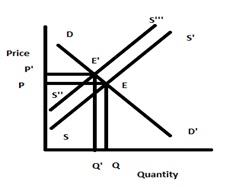
Question 3: How and why is the government seeking to increase competition in the banking sector? Explain your answer with reference to the diagram you constructed in Question 2.
Answer: Government is seeking to increase competition in the banking sector so that the probability of collusion between major banks is reduced. Also with more competition the supply curve SS' can shift downwards and to the right as shown by the yellow line in the graph below. This will happen because with more competition price at every level of output supplied will go down. The equilibrium point now will be E'''. At this point both the output supplied will be bigger and the price charged will be lower.
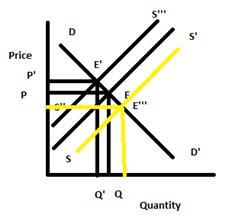
Question 4: Briefly describe what triggers entry in a competitive market and the process that ends further entry. Use a graph in your explanation.
Answer: Entry in a competitive market is triggered by higher profits (Blanchard, 2018). Take the graph below. Initially the supply curve is SS'. Equilibrium point is at E. At this point output supplied is Q and price is P. Now at price P profit margin is very high. This high profit margin attracts new competitors in the industry. This increases supply of output in the industry. Due to this the supply curve comes down to the right to the yellow line. Now the equilibrium point is E'''. Price at this point is much lower than at P. Profit margin in the industry therefore goes down. At this lower price point some of the players start making losses as they are unable to cover their costs at this low price. They therefore exit the industry.
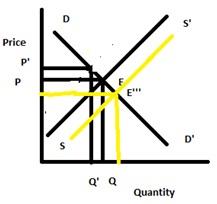
ENROL WITH ECOM4000 ECONOMICS ASSIGNMENT HELP AND HOMEWORK WRITING SERVICES OF EXPERTSMINDS.COM AND GET BETTER RESULTS IN ECOM4000 ECONOMICS ASSIGNMENTS!
Part B: Macroeconomics
Question 1: Explain how "discretionary fiscal policy" can be "countercyclical" and be used to support aggregate demand. Use an AD/AS model to support your answer.
Answer: Fiscal policy means revenues and expenditures of the government (Mishkin, 2016). Discretionary fiscal policy can be countercyclical and can be used to support aggregate demand (Dolamore, 2014). This means that during times of economic slowdown the government can pursue an expansionary fiscal policy by increasing its expenditures. Government expenditure is a part of aggregate demand. Higher government expenditure will increase aggregate demand, thereby increasing economic growth. Similarly during times of economic boom the government can pursue contractionary fiscal policy and reduce its expenditure. This will lower aggregate demand and prevent the economy from overheating (high inflation).
Now in the graph below the slowdown in the economy brings down the AD curve to the left (as shown by the red line). The output of the economy falls to Q' from Q. Now the government pursues expansionary fiscal policy and increases government expenditure. This increases aggregate demand in the economy. The aggregate demand curve AD comes back to its original position. Output of the economy at Q is restored and economic growth increases.
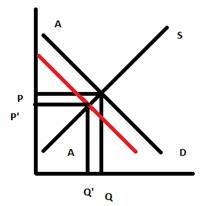
Question 2: Use an AD/AS model to demonstrate where the Australian economy was operating in 2014 in relation to full employment and explain the reasons for this. Based on your diagram, the above sources and your own research what phase of the business cycle do you think the Australian economy was in? Explain your reasoning.
Answer: In 2014 unemployment rate increased in the Australian economy (Pickering, 2014). The AD-AS curve in the graph below shows that full employment level of the economy is at point E. This point is the point of intersection of the AD-AS curve. In 2014, the Australian economy was operating below this point. We have shown point in the graph below as X. At point X equilibrium demand of Q is lower than the full employment demand of Q'.
We can therefore conclude that the Australian economy was operating in the slowdown stage of the business cycle in 2014.
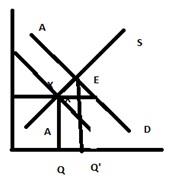
GETTING STUCK WITH SIMILAR ECOM4000 ECONOMICS ASSIGNMENT? ENROL WITH EXPERTSMINDS'S ECOM4000 ECONOMICS ASSIGNMENT HELP SERVICES AND GET DISTRESSED WITH YOUR ASSIGNMENT WORRIES!
Question 3: Based on your research, evaluate the fiscal policy the government is pursuing. Do you believe this is appropriate given the state of the economy? Why or why not? Use an AD/AS diagram in your discussion.
Answer: In the year 2015 that immediately followed the increase in unemployment rate, the fiscal deficit of the Australian government increased to $37.4 billion from around $ 29 billion in 2014-15. This deficit was mainly due to expansionary monetary policy in a number of areas to give a boost to the economy. The government came up with economic stimulus measures such as a $1.1 billion innovation package, $ 1.1 billion in funding for new roads, and subsidies of $ 621 million for the pharmaceutical industry (Woodly & Anderson, 2015). This clearly shows the discretionary expansionary fiscal policy that the government pursued. This expansionary policy was the right one.
As shown in the graph below expansionary fiscal policy of the Australian government could pull up the aggregate demand curve , AD up from the red line (to which the aggregate demand has fallen, causing slowdown and higher unemployment) to its original position at AD.
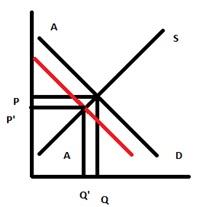
Question 4: Based on your research, evaluate the monetary policy the RBA is pursuing. Do you believe this is appropriate given the state of the economy? Why or why not? Use an AD/AS diagram in your discussion.
Answer: The RBA was pursuing an expansionary monetary policy by keeping interest rate low. Monetary policy is concerned with demand and supply of money and interest rates (Samuelson & Nordhaus, 2018). This expansionary monetary policy of low interest rate is the right one because unemployment rate was high. Inflation rate was coming down in 2014. This low interest rate policy would give a boost to the economy by increasing interest sensitive investment and consumption. This will increase aggregate demand and shift the AD curve to the right. Equilibrium point will now occur at a higher level, E. This would result in lower unemployment rate.
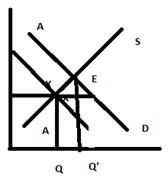
Question 5: What effect do you think the lower dollar could have on inflation in Australia? Why? If in 2015 inflation rose to 4% and unemployment rose to 7% what fiscal policy would you advise the government to pursue? Why? Demonstrate the effects of your proposed policy using an AD/AS model.
Answer: A lower dollar will make Australia's imports more expensive. This will have an effect of increasing inflation rate.
If in 2015 inflation rate rose to 4% and unemployment rate rose to 7% then I would advise the Australian government to pursue an expansionary fiscal policy so that aggregate demand can be raised and unemployment rate can be brought down. The RBA on the other hand will pursue a contractionary monetary policy by increasing interest rates so that inflation rate can be brought down. The negative impact on economic growth and unemployment due to higher interest rates can be offset to some extent by expansionary fiscal policy (Chandra, 2017).
The figure below shows that expansionary fiscal policy in this scenario would push up AD curve and bring down unemployment rate. This will also cause price or inflation to increase (from P to P'). But a contractionary monetary policy of RBA can bring down AD curve to A'D'. Price at this level will be P''. Inflation will be kept under control.
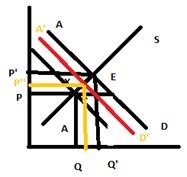
EXPERTSMINDS.COM GIVES ACCOUNTABILITY OF YOUR TIME AND MONEY - AVAIL TOP RESULTS ORIGINATED ECOM4000 ECONOMICS ASSIGNMENT HELP SERVICES AT BEST RATES!
We deliver Kaplan Business School, Australia Assignment Help for other courses and specialized academic units such as -
- ACCM4000 - Accounting Principles Assignment Help
- CLWM4000 - Business & Corporations Law Assignment Help
- STAM4000 - Quantitative Methods Assignment Help
- EAPM4000 - Professional Communication Practice Assignment Help
- FINM4000 - Finance Assignment Help
- GB512 - Business Communications Assignment Help
- CGRM4000 - Corporate Governance & Regulatory Processes Assignment Help
- ACCM4400 - Auditing & Assurance Assignment Help
- CLWM4100 - Taxation Law Assignment Help
- GB518 - Financial Accounting Principles and Analysis Assignment Help